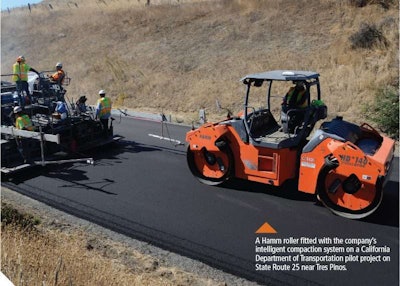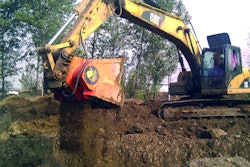
Intelligent compaction (IC) has been the most-touted development in roller technology the past few years. It is quickly becoming a necessity as transportation agencies gradually integrate the requirement for it into their specifications.
For example, by 2018 the Minnesota Department of Transportation will require any project bigger than 5 lane miles to have 100 percent IC compaction. Currently, 21 states and the District of Columbia have some form of specifications in place for the use of IC with asphalt.
Requirements such as these have nudged contractors into implementing the technology.
“We really don’t have a choice in Minnesota to not have IC if you want to bid on the big roads,” says Kirk Langum, director of support services for Hardrives Incorporated. The Rogers, Minnesota-based contractor added IC into their operation for the 2016 season, primarily due to the IC spec requirement on three jobs.
These three jobs, according to Langum, were around the 35,000- to 36,000-ton range and presented crews with some challenges in getting used to the Cat Compaction Control system on their Cat CW34 rubber-tire and two CB66B tandem-drum rollers.
It took some getting used to, admits Langum. Crews achieved 33 and 36 percent potential density on their first two jobs using the compaction system-equipped rollers, but then shot up to 77 percent potential density on the third job. “Familiarity of the system, along with a little bit different mix, helped us improve on that last project,” he says. He adds that having Matt Krier, IC field superintendent, out on the project helped as well.
“With Matt being out there full time and everything daily working like it should, we were able to really monitor rolling patterns and get the coverage we needed to get to get our density,” Langum says.
Top benefits
Much of the focus on IC hones in on stiffness and density, and while these attributes are improved with the use of IC, contractors are beginning to realize that pass mapping and temperature readings are the top benefits, according to Tim Kowalski, applications support manager for Hamm.
“Pass count and temperature are the two things that I try to show people that they need to be monitoring,” he says. “There is too much concentration on stiffness. And a lot of people are under the misconception that stiffness is going to give you density. It doesn’t give you density because stiffness in hot mix is related to temperature and time.”
He says the top factor for compaction is consistency, which is what IC technology is best at monitoring. “The same speed, same amplitude, same frequency, same impact spacing, number of passes and the same temperature range are what we’re looking for. Consistency is what is going to drive the better compaction.”
Krier says the temperature sensors on their rollers gave Hardrives’ operators an advantage in time. “It helped with having temperature sensors on the front and back so the roller operators knew the optimum moment that they could get on that mat,” he says.
Temperature readings are crucial in balancing stiffness and density, says Kowalski. But having tunnel vision solely on stiffness won’t necessarily provide a quality compaction.
“I can pave a mat down and not touch it and it will actually get stiff without rolling it,” he says “But that doesn’t mean I’m going to get compaction.”
Stiffness can provide a lot of hindsight information, Kowalski explains. First, it will indicate if there is a temperature change. Second, it will signify a mix change. Finally, it will show if there’s a change in subgrade.
“Stiffness is not going to tell you density, but it will tell you if something has changed,” he adds. “Now if you get consistent stiffness numbers you know you should get consistent readings, you have a consistent material you’re laying over the top of and a consistent material you are placing.”
Pass mapping
Krier says Hardrives’ operators improved their pass coverage under the Cat IC system because they were able to see where the roller traveled. “Every roller operator admitted that being able to see their patterns was great, but not all of them will admit they were actually missing anything,” he jokes.
“We could see it on the charts their coverage was actually a lot better than when they weren’t using it when we wouldn’t let them see it,” Langum says. “It just really increased their coverage, which really helps us because we never know where a core sample is going to be taken.”
“After we used IC for some time I talked to one of the finish roller operators,” Langum adds. “He said that before he was rolling a lot more than he thought he had to, so he had a little extra time to be more efficient with the time he had. It’s less fuel for us with less use of the rollers.”
However, reaction to adding IC at Hardrives wasn’t necessarily positive in the beginning, says Krier.
“We had a few operators who were not happy about having more technology that they were supposed to rely on added to their machines,” he says, “Some thought we were trying to monitor them and their performance. When they realized that wasn’t the case, that it was just to put forth a better product, they really came around to it. We found a lot of them that would really take the time to learn how to use the display screen and go through the separate screens and look at their temperature and their pass count and their coverage. By the end of the season they really enjoyed using it.”
Much like Hardrives’ operators initial thoughts, Kowalski admits that not all contractors have been enthusiastic about adding IC to their operations. Some have viewed it as a “finger-pointing tool” for state departments of transportation to identify breakdowns in pavement quality.
“Some of the bigger contractors that have been using it early on have found that there has been a benefit to them for what they’re trying to do for consistency,” he says. “I think a lot of it has to do with how the states actually put it into their specs to present it the contractors in how it can be a useful tool for them.
“Manufacturers are constantly upgrading the system and there are more states that are going to a VRS system, or virtual reference station,” Kowalski continues. “States will have their own stations around, and then we can tie into that instead trying to have a separate base or doing something different on our own. So the states are looking to make it easier for the contractors to want to use the system.”
IC as a training tool
One side benefit to the capabilities of IC and all that it can measure is the potential for improving operator skill.
“I see that contractors who have been using it on a regular basis have realized that it is a great tool for training,” Kowalski says. “That is especially the case if you have younger operators that are looking to improve how they are rolling, and looking at pass counts making sure they get the number of passes they need. They also can make sure that their cross over areas on their stop and start are thoroughly vibed through, and not just static, so they can improve the compaction in crossover areas.”
Kowalski says the City of Los Angeles is one of the prime spots for working with an agency on IC integration. “They’re looking at it for training purposes to start with,” he says. “We went out there and did a project with them just to show them how they did things, and they were amazed at how much time they were wasting and over-rolling a lot of the projects, and actually destroying the mat.”
Now he says the city is looking at IC not only as a tool to reduce the number of passes, but a way of saving money on fuel, getting better compaction and longer lasting materials. “They see it as a huge advantage,” he adds.
Langum agrees that the training potential for IC would be beneficial to Hardrives.
“We’re bringing in new and younger people now and moving people to different roles. So I see in the mapping that it’s going to do nothing but help them understand what a rolling pattern is, and what 100 percent coverage looks like. I could see it being a good training tool in the future for new employees as well as our existing employees.”
“I believe as we become more familiar with it, intelligent compaction will help us overall on any job that it is required on, and some that it’s not required on when we choose to use it to achieve a higher density potential for incentives,” says Krier. “When we become more familiar with it, our operators saw that they were getting 100 percent coverage with all their passes and that there was no failed core. We’ll see those density numbers keep on rising.”












